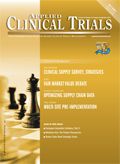Strategic Approach Needed for International Clinical Trials
Applied Clinical Trials
Longer-term strategic issues are making already high-investment, high-risk decisions to place studies overseas even more complex.
Over the past two decades, the decision process for siting overseas clinical trials has become more complex for U.S. pharmaceutical companies. Once a straightforward analysis rooted in time and money, longer-term strategic issues are now pushing to the fore, combining to make these high-investment, high-risk calls even more multifaceted.

These challenges become particularly focused for small pharmaceutical and biotechnology companies with time and resource constraints. There is also a need for smaller companies to lay the groundwork for rapid adoption of their approved product, particularly with diseases unique to certain populations or regions. In those situations, a "hearts and minds" effort with local hospitals and doctors can build a comfort level for rapid use of the drug. Orphan drugs targeting smaller populations can live or die commercially by missteps in the human aspect of the trials conducted in the target geographic populations...poisoning the well, as it were.

Treatments, cultures, and attitudes manifest themselves in different ways in different countries on different continents. One example in our own experience revolved around early brain trauma following subarachnoid hemorrhage. Japan offers a unique opportunity for study in this area, as its medical system is geared towards treating all serious headaches as potential indicators of a severe underlying brain injury. Accordingly, diagnostic and treatment habits and practices are directed at rapid intervention in hopes of preventing a more serious outcome. Where U.S. clinicians may routinely wait 24-48 hours to see if headaches persist, the Japanese medical community tends to act earlier, presenting a unique opportunity for clinical research. Conversely, a drug that is efficacious for early symptoms may not be if given in a later phase of progression. While that complicates the decision-making process for an individual clinical trial strategy, the opportunity to test for early intervention efficacy is a powerful incentive to test in Japan.
At Prolong, the primary focus of our clinical research is on sickle cell disease (SCD), a genetic disease that presents in multiple comorbidities. Ranging from such diverse indications as dactylitis, vaso-occlusive crisis, stroke, leg ulcers, and several cardiac/pulmonary abnormalities, sickle cell disease is both an orphan indication in the U.S. (with about 100,000 patients) and a continent-wide problem, with 12 million sufferers in Africa. The Middle East and South America are seeing rising SCD populations as well.
Clinical trials are, of course, the basis for a drug's approval and comprise the main body of evidence for safety and efficacy. Of critical consideration is that product licensure is based on assessing the totality of the scientific evidence. This longstanding concept has formed the basis for many food, drug, and device approvals/rejections around the world.
The totality of scientific evidence is not limited to where clinical trials were conducted or by the unique habits and practices of a given geographic location. Accordingly, a clinical development plan to secure the totality of evidence can be parsed among locations depending on the strategic objective(s). Early acute intervention versus staged chronic treatment requires very different clinical trial designs, protocols, and monitoring strategies. It may also require different global locations to successfully acquire independent data sets that, together, will form the totality of scientific evidence.
In short, international siting for trials offer opportunities for enhanced patient populations or treatment environments more appropriate to a trial's requirements. At the same time, once these benefits are identified, various concerns must be weighed to ensure that the trials, if conducted in future key markets, take that into consideration when interacting with local clinicians and patients.

Improving Relationships and Diversifying the Site Selection Process
April 17th 2025In this episode of the Applied Clinical Trials Podcast, Liz Beatty, co-founder and chief strategy officer, Inato, discusses a number of topics around site engagement including community-based sites, the role of technology in improving site/sponsor relationships, how increased operational costs are impacting the industry, and more.
Behind the Buzz: Why Clinical Research Leaders Flock to SCOPE Summit
February 7th 2025In this episode, we meet with Micah Lieberman, Executive Conference Director for SCOPE Summit (Summit for Clinical Ops Executives) at Cambridge Innovation Institute. We will dive deep into the critical role of collaboration within the clinical research ecosystem. How do we bring together diverse stakeholders—sponsors, CROs, clinical trial tech innovators, suppliers, patients, sites, advocacy organizations, investors, and non-profits—to share best practices in trial design, program planning, innovation, and clinical operations? We’ll explore why it’s vital for thought leaders to step beyond their own organizations and learn from others, exchanging ideas that drive advancements in clinical research. Additionally, we’ll discuss the pivotal role of scientific conferences like SCOPE Summit in fostering these essential connections and collaborations, helping shape the future of clinical trials. Join us as we uncover how collective wisdom and cross-industry partnerships are transforming the landscape of clinical research.


















